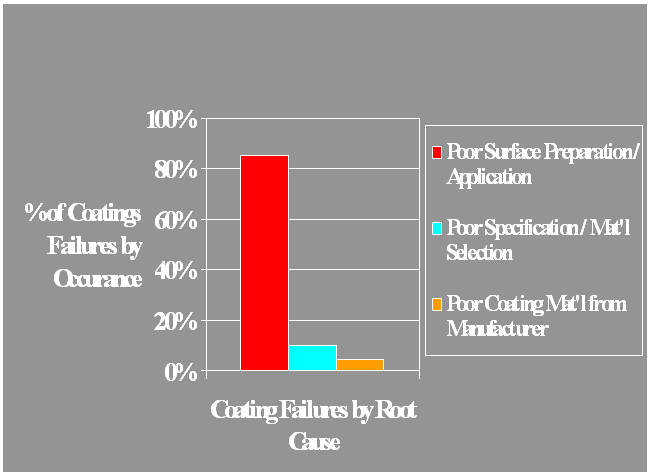
| 7. Coating Failures | |
|
7.3 Systems and Coatings |
|
Systems and Coatings
Figure below shows the percentage of coating failures, classified according to the root cause. It can be seen that the majority of failures occur due to poor surface preparation.

The following points are important to the prevention of coatings from failure
Type of Paint: The nature of the paint to be used is very important. A right paints is to be selected for the right system. For instance, for harbors and jetliners, the paint must have a good impact, abrasion and immersion resistance as the marine environment is highly corrosive. For tank lining a highly chemical resistant tank linings are needed to avoid contamination of the fuels, and protect the tank from corrosion. For immersion services, the coating must include and impervious vinyl coal tar coatings.
Solvent: Choice between solvent free and solvent borne coatings: Proper choice must be made between selection of a solvent free, solvent based and waterborne paints. The solvent free coatings are based on low molecular epoxy resins and solvent borne are based on high molecular epoxy resins which require strong solvent. Several epoxy based solvents, fire coatings are suitable for pitted tank tops and single hull vessels. Traditional solvent based coatings in typical highly corrosive applications encountered in chemical transportation and storage. Solvent free coatings find favorable applications in drinking water systems.
Waste water treatment: The waste water treatment plants require coatings to prevent corrosion of steel, concrete and control of slime growth. The primary settling tanks produce highly corrosive environments. Three coat epoxy systems have been successfully used.
Surface preparation standards: Any coating system would be effective if the substrate has been prepared in accordance with the set standards for surface preparation. Following are the recognized standards in this regard.
| Standard | Description |
| ISO 8501 - 01 | International Standards Organization |
| ISO 8504 | International Standards Organization |
| SPSS - 1975 | Japanese Standard |
| DIM 55928 | German Standard |
| BS 4132 | British Standard |
| SSPC - V1S1 | American Standard |
Economics: A judicious balance is to be maintained between economy, quality and the life expectancy of the coating. Any imbalance would lead to pre-mature failure.
Quality: The quality of the volume solids is more important than the quantity of solids. Lesser percentage of volume of high quality is preferred over high percentage of low quality volume solids.
|
Good job |
Poor job |
Ingredients of a Successful Coating System
The following ingredients of a successful coating system are summarized below:
Strict adherence to paint specification.
Use of proven and compatible application technique.
Excellent surface preparation.
Compatibility of the coating with the system and the environment.
quality control of the painting.
Inspection, monitoring and maintenance.
Involvement of certified engineers and skilled manpower.
Balanced judgment between economics and the paint's life.
Inventory of past failures.
|
|